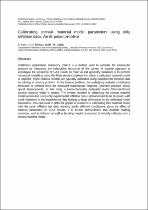 ResearchSpace
ResearchSpace
Calibrating corneal material model parameters using only inflation data: an ill-posed problem
JavaScript is disabled for your browser. Some features of this site may not work without it.
- ResearchSpace
- →
- Research Publications/Outputs
- →
- Journal Articles
- →
- View Item
| dc.contributor.author |
Kok, S

|
|
| dc.contributor.author |
Botha, N

|
|
| dc.contributor.author |
Inglis, M

|
|
| dc.date.accessioned | 2015-03-12T09:56:43Z | |
| dc.date.available | 2015-03-12T09:56:43Z | |
| dc.date.issued | 2014-08 | |
| dc.identifier.citation | Kok, S, Botha, N and Inglis, M. 2014. Calibrating corneal material model parameters using only inflation data: an ill-posed problem. International Journal for Numerical Methods in Biomedical Engineering, vol. 30(12), pp 1460–1475 | en_US |
| dc.identifier.issn | 2040-7939 | |
| dc.identifier.uri | http://onlinelibrary.wiley.com/doi/10.1002/cnm.2667/pdf | |
| dc.identifier.uri | http://hdl.handle.net/10204/7923 | |
| dc.description | Copyright: 2014 John Wiley & Sons.Due to copyright restrictions, the attached PDF file only contains the abstract of the full text item. For access to the full text item, please consult the publisher's website. | en_US |
| dc.description.abstract | Goldmann applanation tonometry (GAT) is a method used to estimate the intraocular pressure by measuring the indentation resistance of the cornea. A popular approach to investigate the sensitivity of GAT results to material and geometry variations is to perform numerical modelling using the finite element method, for which a calibrated material model is required. These material models are typically calibrated using experimental inflation data by solving an inverse problem. In the inverse problem, the underlying material constitutive behaviour is inferred from the measured macroscopic response (chamber pressure versus apical displacement). In this study, a biomechanically motivated elastic fibre-reinforced corneal material model is chosen. The inverse problem of calibrating the corneal material model parameters using only experimental inflation data is demonstrated to be ill-posed, with small variations in the experimental data leading to large differences in the calibrated model parameters. This can result in different groups of researchers, calibrating their material model with the same inflation test data, drawing vastly different conclusions about the effect of material parameters on GAT results. It is further demonstrated that multiple loading scenarios, such as inflation as well as bending, would be required to reliably calibrate such a corneal material model. | en_US |
| dc.language.iso | en | en_US |
| dc.publisher | John Wiley & Sons | en_US |
| dc.relation.ispartofseries | Workflow;13468 | |
| dc.subject | Inverse problem | en_US |
| dc.subject | Ill-posed | en_US |
| dc.subject | Material coefficient calibration | en_US |
| dc.subject | Elastic fibre-reinforced constitutive model | en_US |
| dc.subject | Inflation test | en_US |
| dc.subject | Goldmann applanation tonometry | en_US |
| dc.subject | GAT | en_US |
| dc.subject | Cornea | en_US |
| dc.title | Calibrating corneal material model parameters using only inflation data: an ill-posed problem | en_US |
| dc.type | Article | en_US |
| dc.identifier.apacitation | Kok, S., Botha, N., & Inglis, M. (2014). Calibrating corneal material model parameters using only inflation data: an ill-posed problem. http://hdl.handle.net/10204/7923 | en_ZA |
| dc.identifier.chicagocitation | Kok, S, N Botha, and M Inglis "Calibrating corneal material model parameters using only inflation data: an ill-posed problem." (2014) http://hdl.handle.net/10204/7923 | en_ZA |
| dc.identifier.vancouvercitation | Kok S, Botha N, Inglis M. Calibrating corneal material model parameters using only inflation data: an ill-posed problem. 2014; http://hdl.handle.net/10204/7923. | en_ZA |
| dc.identifier.ris | TY - Article AU - Kok, S AU - Botha, N AU - Inglis, M AB - Goldmann applanation tonometry (GAT) is a method used to estimate the intraocular pressure by measuring the indentation resistance of the cornea. A popular approach to investigate the sensitivity of GAT results to material and geometry variations is to perform numerical modelling using the finite element method, for which a calibrated material model is required. These material models are typically calibrated using experimental inflation data by solving an inverse problem. In the inverse problem, the underlying material constitutive behaviour is inferred from the measured macroscopic response (chamber pressure versus apical displacement). In this study, a biomechanically motivated elastic fibre-reinforced corneal material model is chosen. The inverse problem of calibrating the corneal material model parameters using only experimental inflation data is demonstrated to be ill-posed, with small variations in the experimental data leading to large differences in the calibrated model parameters. This can result in different groups of researchers, calibrating their material model with the same inflation test data, drawing vastly different conclusions about the effect of material parameters on GAT results. It is further demonstrated that multiple loading scenarios, such as inflation as well as bending, would be required to reliably calibrate such a corneal material model. DA - 2014-08 DB - ResearchSpace DP - CSIR KW - Inverse problem KW - Ill-posed KW - Material coefficient calibration KW - Elastic fibre-reinforced constitutive model KW - Inflation test KW - Goldmann applanation tonometry KW - GAT KW - Cornea LK - https://researchspace.csir.co.za PY - 2014 SM - 2040-7939 T1 - Calibrating corneal material model parameters using only inflation data: an ill-posed problem TI - Calibrating corneal material model parameters using only inflation data: an ill-posed problem UR - http://hdl.handle.net/10204/7923 ER - | en_ZA |





